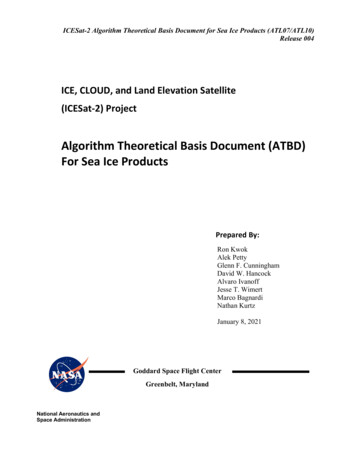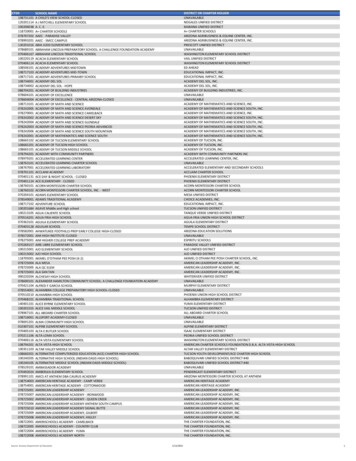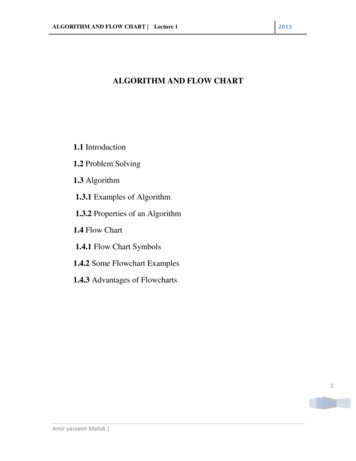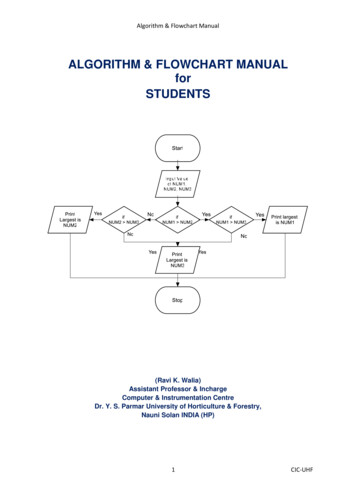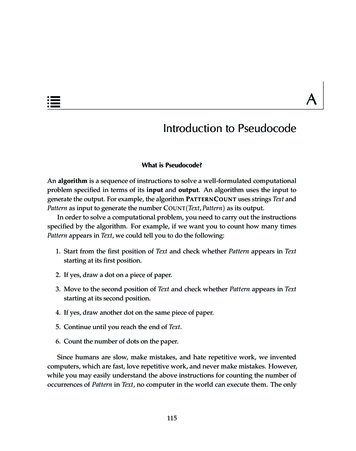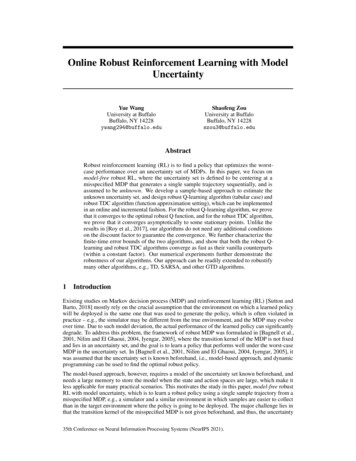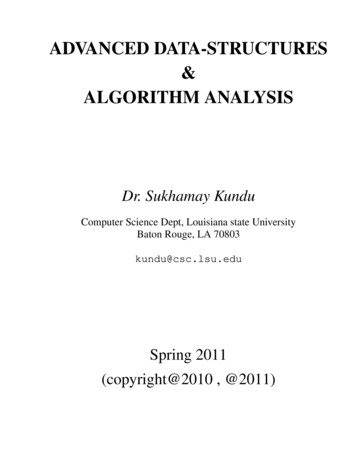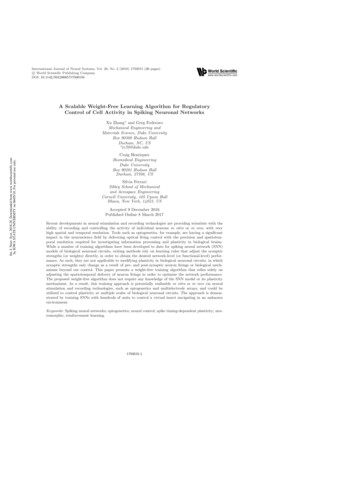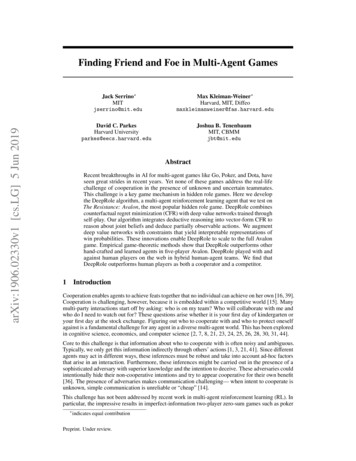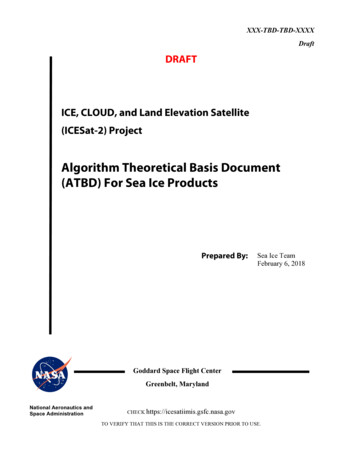
Transcription
XXX-TBD-TBD-XXXXDraftDRAFTICE, CLOUD, and Land Elevation Satellite(ICESat-2) ProjectAlgorithm Theoretical Basis Document(ATBD) For Sea Ice ProductsPrepared By:Sea Ice TeamFebruary 6, 2018Goddard Space Flight CenterGreenbelt, MarylandNational Aeronautics andSpace AdministrationCHECK https://icesatiimis.gsfc.nasa.govTO VERIFY THAT THIS IS THE CORRECT VERSION PRIOR TO USE.
XXX-TBD-TBD-XXXXDraftCHECK https://icesatiimis.gsfc.nasa.govTO VERIFY THAT THIS IS THE CORRECT VERSION PRIOR TO USE.
XXX-TBD-TBD-XXXXDraftAbstractThis document describes the theoretical basis of the sea ice processing algorithms and theproducts that are produced by the ICESat-2 mission. It includes descriptions of the parametersthat are provided with each product as well as ancillary geophysical parameters used in thederivation of the along-track and gridded sea ice products.iiiRelease Date TBD
XXX-TBD-TBD-XXXXDraftCM ForewordThis document is an Ice, Cloud, and Land Elevation (ICESat-2) Project Science Officecontrolled document. Changes to this document require prior approval of the ScienceDevelopment Team ATBD Lead or designee. Proposed changes shall be submitted in theICESat-II Management Information System (MIS) via a Signature Controlled Request(SCoRe), along with supportive material justifying the proposed change.Questions or comments concerning this document should be addressed to:ICESat-2 Project Science OfficeMail Stop 615Goddard Space Flight CenterGreenbelt, Maryland 20771ivRelease Date TBD
XXX-TBD-TBD-XXXXDraftPrefaceThis document is the Algorithm Theoretical Basis Document for the processing of sea ice datato be implemented at the ICESat-2 Science Investigator-led Processing System (SIPS). TheSIPS supports the ATLAS (Advanced Topographic Laser Altimeter System) instrument on theICESat-2 Spacecraft and encompasses the ATLAS Science Algorithm Software (ASAS) andthe Scheduling and Data Management System (SDMS). The science algorithm software willproduce Level 0 through Level 4 standard data products as well as the associated productquality assessments and metadata information.The ICESat-2 Science Development Team, in support of the ICESat-2 Project Science Office(PSO), assumes responsibility for this document and updates it, as required, as algorithms arerefined or to meet the needs of the ICESat-2 SIPS. Reviews of this document are performedwhen appropriate and as needed updates to this document are made. Changes to this documentwill be made by complete revision.Changes to this document require prior approval of the Change Authority listed on thesignature page. Proposed changes shall be submitted to the ICESat-2 PSO, along withsupportive material justifying the proposed change.Questions or comments concerning this document should be addressed to:Thorsten Markus, ICESat-2 Project ScientistMail Stop 615Goddard Space Flight CenterGreenbelt, Maryland 20771viRelease Date TBD
XXX-TBD-TBD-XXXXDraftReview/Approval PagePrepared by:Ron KwokJet Propulsion LaboratoryCalifornia Institute of TechnologyPasadena, CA 91109Reviewed by: Enter Position Title Here Enter Org/Code Here Enter Position Title Here Enter Org/Code Here Approved by:Thorsten MarkusICESat-2 Project ScientistMail Stop 615Goddard Space Flight CenterGreenbelt, Maryland 20771*** Signatures are available on-line at: https:// /icesatiimis.gsfc.nasa.gov ***viiRelease Date TBD
XXX-TBD-TBD-XXXXDraftChange History LogRevisionLevel1.0Description of ChangeSCoReNo.DateApprovedInitial ReleaseviiiRelease Date TBD
XXX-TBD-TBD-XXXXDraftList of TBDs/TBRsItemNo.LocationSummaryInd./Org.Due DateixRelease Date TBD
XXX-TBD-TBD-XXXXDraftTable of ContentsAbstract . iiiCM Foreword . ivPreface . viReview/Approval Page . viiChange History Log . viiiList of TBDs/TBRs . ixTable of Contents . xList of Figures . xiiiList of Tables . xvi1 INTRODUCTION . 12 BACKGROUND . 22.1 Overview: sea ice freeboard and thickness . 22.2 Photon counting altimetry over sea ice . 62.2.1 Expected ATLAS performance over sea ice . 72.2.2 Signal vs. background photons: Examples from MABEL . 82.2.3 Sea ice in two MABEL file-segments . 112.2.4 Height distributions . 122.2.5 Potential error sources . 133 SEA ICE PRODUCTS . 183.1 Surface height product (ATL07/L3A) . 193.1.1 Segment spacing . 193.1.2 Parameters in a height segment . 193.1.3 Input from IS-2 Products (ATL03 and ATL09) . 233.1.4 External inputs (see Section 7) . 243.2 Sea Ice Freeboard (ATL10/L3A) . 253.2.1 Sampling (Swath-segment) . 253.2.2 Parameters in a freeboard swath-segment . 253.2.3 External input (see Section 7) . 253.3 Gridded Sea Ice Freeboard (ATL20/L3B) . 273.3.1 Grid Parameters . 273.3.2 External input . 273.4 Gridded Sea Surface Height - Ice-covered Ocean (ATL21/L3B) . 283.4.1 Grid Parameters . 283.4.2 External input . 28xRelease Date TBD
XXX-TBD-TBD-XXXXDraft4 ALGORITHM DESCRIPTION: ATL07 . 294.1 Input parameters . 314.1.1 Source: ATL03 . 314.1.2 Source: ATL09 . 334.1.3 External (time-varying/static fields - see Section 7) . 334.2 Finding the surface. 344.2.1 Coarse surface-finding . 344.2.2 Fine surface-finding: Fitting the expected return to the photon cloud . 374.2.3 Background rates (MHz) . 434.2.4 Surface height histogram statistics and height quality estimates . 464.2.5 Expected uncertainties in retrieved surface height . 474.2.6 Correction for skews in the surface height distributions . 494.3 Surface classification (Ice/water discrimination) . 544.3.1 Basis for surface classification . 544.4 Output of surface finding algorithm . 595 ALGORITHM DESCRIPTION: ATL10 . 625.1 Basis for freeboard estimation . 625.1.1 Control parameters . 635.1.2 Dataflow and procedural steps . 635.1.3 Expected uncertainties in freeboard determination . 665.1.4 Procedure to fill missing surface reference estimates along track . 675.2 Output of freeboard estimation algorithm . 696 ALGORITHM DESCRIPTION: Gridded Freeboard (ATL20) and Sea surface Height(ATL21) . 726.1 Gridded fields of freeboard and sea surface height . 726.1.1 Control parameters . 726.1.2 Dataflow and procedural steps (ATL20) . 726.1.3 Dataflow and procedural steps (ATL21) . 727 ALGORITHM IMPLEMENTATION CONSIDERATIONS . 757.1 Multi-beam Architecture: Surface Finding/Classification . 767.2 Product Coverage (ATL07 and ATL10) . 777.2.1 Northern Hemisphere Sea Ice Cover . 787.2.2 Southern Hemisphere Sea Ice Cover . 797.3 Parameters Required from ATLAS . 807.3.1 System impulse response. 807.4 Parameters from Ancillary Sources . 807.4.1 Gridded ice concentration . 807.4.2 Mean sea surface (MSS) . 807.4.3 Land Mask and distance from Land . 808 BrOWse ProducTs. 818.1 ATL07 . 818.1.1 Line plots (beams) . 81xiRelease Date TBD
XXX-TBD-TBD-XXXXDraft8.1.2 Histogram . 818.2 ATL10 . 818.2.1 Line plots (beams) . 818.2.2 Histogram . 819 DATA Quality . 829.1 Statistics . 829.1.1 Per orbit Statistics – ATL07 . 829.1.2 Per orbit Statistics – ATL10 . 8610 Test Data . 9310.1 Data sets . 9311 CONSTRAINTS, LIMITATIONS, AND ASSUMPTIONS . 9411.1 Constraints . 9411.2 Limitations . 9411.3 Assumptions . 9412 References . 96List of Acronyms . 98Glossary . 100APPENDIX A: ATL07 Surface heights. 105APPENDIX B: ATL10 Sea ice freeboard . 114APPENDIX C: ATL20 Gridded freeboard . 127APPENDIX D: ATL21 Gridded Sea Surface Height . 128APPENDIX E: Expectation-Maximization (EM) Procedure . 129! to correct biases Δhcorr due to skews in the heightAPPENDIX F: Construction of table ( g)distributions . 130APPENDIX G: Source/calculation of background rates. 132APPENDIX H: Polar Stereographic Projection and Grid . 134APPENDIX I: Mean Sea Surface, Land Mask and Distance Map (Gridded fields) . 136xiiRelease Date TBD
XXX-TBD-TBD-XXXXDraftList of FiguresFigurePageFigure 1 Geometric relationships . 3Figure 2 Near-coincident RADARSAT and ICESat-1 datatakes. (a) Geographic location ofdata. (b) ICESat track (dashed yellow line) and new leads/openings seen in timeseparated RADARSAT images over the same area on the ice cover. (c) ICESat freeboardprofile and estimated ice draft (snow: light blue; ice: dark blue). (d) Uncorrectedreflectivity along the track. (e) The thickness distribution with three superimposed snowcovers (red: climatological mean 10cm; black: mean; green: mean-10cm). (RADARSATimagery CSA 2004). The inset in (d) shows the sigmoidal function for applying snowdepth. The vertical scale depends on the climatological snow depth at the geographiclocation of interest. Yellow bands highlight sea ice leads in the radar and lidar data. . 5Figure 3 Multi-beam profiling of the surface with ICESat-2. The ATLAS instrument consistsof 6 lidar beams or three pairs of beams separated by 3 km across track. For each pair,there is a strong and weak beam separated by 90 m across track. . 6Figure 4 MABEL flightlines (on April 08, April 10) plotted on an Envisat Synthetic ApertureRadar (SAR) mosaic of the region acquired on April 8. Near-coincident ATM data fromOperation IceBridge were acquired on April 10. Inset shows the ER-2 aircraft. MABEL islocated in the nose of the platform. The segments discussed in section are from flightlinessouth of the Fram Strait. . 9Figure 5 Calculated (black line) and observed (solid circles) solar background rates over theflightlines on April-08 (left) and April-10 (right). See Figure 1 for location of theseflightlines. . 10Figure 6 Returns from the sea ice cover (Channel 6) along a cloud-free 5.5 km MABELtrack. (a) DCS (Digital Camera System) image containing the MABEL track. (b) Totalphoton counts from two height intervals: Surface (-3 to 4 meters) and background (4 to5000 meters). Photon counts are sums of returns from 125 pulses ( 5 m along track).Note the different scales for background (left) and surface (right) counts. (c) Photonheights. Color represents total counts in 125 pulses. (d) Number of pulses needed toaggregate at least 100 signal photons. (e) Retrieved height. Location of this MABELsegment is shown in Figure 4. Transparent light-blue band shows characteristics ofphotons originating near the sea surface. . 15Figure 7 Same as previous figure, but for a different segment. . 16Figure 8 Elevation distributions of leads (left), open-water (center), and snow-covered surfaces(right) (Channel 6). (a) Photon counts along a cloud-free MABEL file-segment (300,000xiiiRelease Date TBD
XXX-TBD-TBD-XXXXDraftpulses and 13 km): Surface (-3 to 4 meters) and background (4 to 5000 meters); countsare 125-shot total. Note the different scales. (b) Photon heights; color represents total ofcounts in 125-shot ( 5 m along track). (c) Photon counts of sub-segment indicated by adark black line in (b). (d) Photon elevations within the sub-segment. (e) Elevationdistributions within the sub-segment (bin size 2.5 cm). Quantities in top right cornershow the mean and standard deviation of the distributions. The plots in the center panelshare the y-axis labels found in the left and right panels. . 17Figure 9 Shifts in the median range for weak-beam (top) and strong-beam (bottom) returns fora range of incident photon counts and return-pulse σ values (1 ns 15 cm). At left arethe shifts for the uncorrected returns, at right are the shifts after correction. (Provided byB. Smith, please see Land Ice ATBD for a more detailed description of the correctionprocedure). 22Figure 10 Region for freeboard calculations. . 26Figure 11 Flowchart: Production of ATL07. . 30Figure 12 Flowchart: Coarse surface finding (used for strong beams only). . 36Figure 13 Surface height retrieval using 100 photon aggregates. (a) Photon cloud from a 6.5km segment of MABEL acquisitions. (b) half-width of Gaussian from retrieval process.(c) Retrieved height. (d) Height distributions and modeled returns (red) (at locations A,B, and C in (c)). (e) Error surface. The light- and dark-gray lines in (e) show the localminima along the x-axis (half-width of Gaussian) and y-axis (elevation offset),respectively. Colors show relative size of the minima. Panels a, b, and c share the same xaxis (labeled in c). . 39Figure Figure 14 Flowchart: Fine surface finding. . 45Figure 15. Two-component mixtures in Mabel height distributions (April 8, 2012). (a)Expectation-Maximization (E-M) procedure provides estimates of the parameters in theMabel height distributions. (b) Distribution of width (w) from the surface findingprocedure as a function of Δµ and α from the EM procedure. (c) Distributions of σ 1 ,σ 2.(d) Density of population as a function of Δµ and α from the EM procedure, and thelocation of the impulse response in the two-component space. . 51Figure 16 Correction of the estimated height from the surface finding procedure for skew indistribution. (a) Distribution of corrections before accounting for the tail in the systemimpulse response. (b) Potential weighting functions to account for system impulseresponse. (c) Distribution of corrections after accounting for the tail in the system impulseresponse. (d) Distribution of corrections applied to the April-8 data. 52Figure 17 Decision tree: Surface classification (Winter Arctic). . 58xivRelease Date TBD
XXX-TBD-TBD-XXXXDraftFigure 18 Relationship between sea surface height segments (SSHseg), leads, and thereference surface (refsurf) for computing freeboards . 62Figure 19 Freeboard estimation. 68Figure 20 Flowchart: Multibeam architecture. . 76Figure 21 Northern and Southern Hemisphere ice covers. . 77Figure 22 Spot and track naming convention with ATLAS oriented in the forward (instrumentcoordinate x) direction. . 103Figure 23 Spot and track naming convention with ATLAS oriented in the backward(instrument coordinate -x) direction. . 104Figure 24 Coverage of SSM/I Grid. . 135xvRelease Date TBD
XXX-TBD-TBD-XXXXDraftList of TablesTablePageTable 1 ICESat-2 Instrument parameters and expected signal levels over sea ice (Dec 2014) . 7Table 2 Input parameters (Source: ATL03) . 31Table 3 Input parameters (Source: ATL09) . 33Table 4 Control parameters – coarse surface finding . 34Table 5 Control parameters – fine surface finding . 40Table 6 Uncertainties in retrieved surface height (100 photons) . 48Table 7 Control parameters – surface classification . 56Table 8 Output to ATL07 (See Appendix A for full product specification) . 59Table 9 Control parameters – freeboard estimation . 63Table 10 Uncertainties due to surface tilts . 67Table 11 Output to ATL10 (See Appendix B for full product specification) . 69Table 12 Control parameters – Gridded products . 72Table 13 Output to ATL20 (See Appendix C for full product specification) . 73Table 14 Output to ATL21 (See Appendix D for full product specification) . 74Table 15 Coverage of ICESat-2 Products in the Northern Hemisphere . 78Table 16 Coverage of ICESat-2 Products in the Southern Hemisphere . 79Table 17 Parameters from ICESat-2 . 80Table 18 Parameters from Ancillary Sources . 80Table 19 Current Test Data Sets . 93Table 20 Grid Dimensions . 134Table 21Northern and Southern Hemisphere Grid Coordinates . 135Table 22 MSS of the Arctic and Southern Oceans (file). 136Table 23 Land Mask and distance map . 136xviRelease Date TBD
XXX-TBD-TBD-XXXXDraftxviiRelease Date TBD
XXX-TBD-TBD-XXXXDraft1 INTRODUCTIONThis document describes the theoretical basis of the sea ice processing algorithms and theparameters that are derived from the ATLAS data acquired by the ICESat-2 mission. ATLAS(Advanced Topographic Laser Altimeter System) is the photon counting lidar onboard theICESat-2 Observatory.The ATLAS-based sea ice products include:1.2.3.4.Along-track sea ice and sea surface heights (Product: ATL07/L3A).Along-track sea ice freeboard (ATL10/L3A).Gridded monthly sea ice freeboard (ATL20/L3B).Gridded monthly sea surface height (ATL21/L3B).Section 2 provides an overview of the retrieval approaches and a short discussion of thephenomenology of photon clouds from sea ice using data acquired by the Multiple AltimeterBeam Experimental Lidar (MABEL), a technology demonstrator for the ATLAS instrument.Section 3 describes the geophysical parameters of interest that reside in each product.Section 4 specifies the sea ice algorithms used in the derivation of surface heights and surfacetypes (ATL07).Section 5 specifies the sea ice algorithms used in the derivation of sea ice freeboard (ATL10).Section 6 addresses specific implementation details/considerations and data requirements thatare not addressed in the above sections. Topics include: software architecture for multi-beamsystem; bounds of geographic and seasonal coverage by the different products in the Arcticand Southern Oceans; and, parameters required by the algorithms that are produced by theICESat-2 project or from an external source.Section 7 lists the data sets that have been used for development and testing of the processingalgorithms.Section 8 lists the constraints, limitations, and assumptions.1Release Date TBD
XXX-TBD-TBD-XXXXDraft2 BACKGROUNDThis section describes the sea ice parameters derived from ICESat2/ATLAS altimetry andprovides an overview of the approaches used to retrieve these variables. Also, a shortdiscussion of the phenomenology of photon clouds over sea ice is provided.When conditions allow, the ICESat-2 sea ice products provide estimates of the followingparameters of the ice-covered seas of the northern and southern hemispheres:1. Surface height and type.2. Total freeboard.These parameters are provided in along-track and gridded formats.Even though a sea
CHECK https://icesatiimis.gsfc.nasa.gov TO VERIFY THAT THIS IS THE CORRECT VERSION PRIOR TO USE. DRAFT ICE, CLOUD, and Land Elevation Satellite (ICESat-2) Project Algorithm Theoretical Basis Document (ATBD) For Sea Ice Products Prepared By: Goddard Space Flight Center Greenbelt, Maryland N
